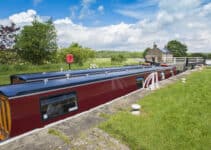We all love our canal boats and hate the idea of them getting old and worn out. Yes, canal cruisers are ‘house proud’ too you know! A lot of people might immediately think of things such as worn out furniture and fittings or even an ageing broken down engine as the most obvious things to watch out for. But there is a hidden danger to all our boats that needs to be discussed and hopefully kept at bay! The dreaded curse of condensation. Yes, canal boats are supposed to keep the water out and condensation is the biggest threat to this. Let’s tackle it together today.
What is Condensation and Why Does it Happen?
We have all witnessed condensation. I can remember as a young child waking up on a winter morning and trying to peer out of the window, only to be confronted with a pane full of condensation. But the big question is how do we tackle it? If we want any hope at tackling condensation, first we need to understand the beast ???? I am no scientist but here it goes!
Condensation occurs when water vapor or water droplets are at a higher pressure than the surrounding air. Condensation can happen in two ways – it can happen on an object that had been recently heated, or when atmospheric conditions cause moisture to saturate an insulating material. It usually happens when the humidity reaches 100 percent and there is a temperature difference of 40 degrees or more between the object and its surroundings.The vapor is cooled and condenses on surfaces with which it comes into contact, like windows, mirrors, floors, etc. This creates foggy buildup on windows that we have all seen many times!
In layman’s terms, you will usually see condensation when warmer air comes into contact with colder surfaces. This is why it is something we often associate with Winter. We heat up our boats and they become humid inside whilst surfaces like windows are still cold. This is the main reason we might see condensation on a boat.
Why is Condensation Bad on a Narrowboat or Canal Boat?
Not only will condensation make nearby things wet if left unchecked, but mould will start to form. Mould in any enclosed space is not good and could be bad for any boater’s health. And for any boat proud canal goer the resulting musty smelling boat interior is a big no-no!
Top Tips for Preventing Mould on a Narrowboat or Canal Boat
Ventilation
Ventilation is key against the fight with condensation and a damp interior on your boat. It gives your warm and moisture laden air somewhere to go before it turns to condensation. So make sure you have good boat ventilation even in the winter. You could use vents to do this or even an extractor fan or two. I have seen some people fitting small fans to their rooftop mushroom vents, for example. These can be turned on to increase ventilation when needed.
A growing trend for narrowboats is the solar vents you can use to extract warm air and ventilate your boat using something powered by solar. On a power limited boat, these can be invaluable. Click the image below to view this one I found over at Amazon.

You also need to consider the ventilation to anything prone to dampness. A big one would be condensation, causing a damp mattress. The problem is that the mattress traps moist air between itself and the bed base, causing some dampness issues. The best solution is to drill holes in your bed base board to let air through. If this still doesn’t work, you can buy a thin mattress underlay that can be placed under the mattress and is made from a material good for ventilation. You can click the image below of a good example I found over at Amazon to check it out for yourself.

Moisture Traps
Anyone that has ever lived in a hot and humid country will know the value of moisture traps in a hot and humid environment. These also come in handy on a narrowboat. I personally like the long and thin style moisture traps, as I feel I can get them into most nooks and crannies where moisture may build up. But go for whatever shape best suits your boat’s interior space. Don’t go too crazy on these moisture traps though, as they are using up valuable space in your already compact canal boat. Finally, make sure to buy refillable moisture traps so you are at least throwing less plastic crap away ????
I like these below from Amazon. Click the image to view them for yourself over there.

Clothes Drying
I know this may be hard for narrowboaters, especially in Winter, but drying clothes inside your canal boat will create a lot of excess moisture that needs to escape. Either try not to dry clothes inside your boat or at least only dry clothes in a separate enclosed space with very good ventilation!
Think of Gaps
Any time two surfaces come together and trap moist air, there is a potential for condensation to form. Something a lot of people forget about is furniture. Wherever possible, try to leave a gap between any furniture and the walls of your narrowboat. If this is not possible, at least be aware of the fact that condensation could form in these places and wipe regularly.
Double Glazed Windows
For many canal boaters, their windows are the biggest source of condensation, as the warm air inside the boat hits the colder windows. The best way to avoid or lessen this would be to fit double-glazed windows into your boat. This would mean that the pane of glass on the inside (that comes into contact with your heated moist air) wouldn’t be as affected by the fluctuating outside temperatures and would be less likely to cause condensation.
If you don’t have double-glazed windows and think they are a bit out of your price range to have fitted, there are cheaper alternatives. You can buy double glazing film which will create a double glazed like effect for those on a budget. Check out the example I found on Amazon below. Click the image to view it for yourself.

If you go with this type of film, take care to read and follow the instructions in full. I have heard some horror stories about people not getting good results when ‘winging it’.
Wipe Up!
If you are still struggling with moisture and condensation on your narrowboat, then you should at the very least go around regularly to wipe up any that you find. Some people like to make wiping off the inside of their windows a regular morning routine. If you are wiping it up, it means it can’t make things wet and create mould.
What Not to Do with Moisture on Your Canal Boat!
The Dreaded De-Humidifier
A lot of boaters instantly think of an electric de-humidifier when trying to tackle condensation. But for me personally, I think they are a massive waste of energy. If you are a continuous cruiser, don’t bother unless you have a massive solar array to run your de-humidifier from ????
Even if you are a marina bound boater, at least think of the amount of energy these machines use before going ahead, as you may be surprised at how the costs mount up. Use an energy usage calculator and be fully clued up before you take the plunge.
Energy is precious on a boat and I think you can tackle this condensation issue without resorting to such an energy hogging machine!
Hopefully, today I have given you at least a starting point to tackling condensation on your canal boat!



![What Happened to Cruising The Cut [Narrowboat Youtuber]](https://canalboatuk.com/wp-content/uploads/2022/08/cruising-the-cut-youtube-channel-211x150.png)
